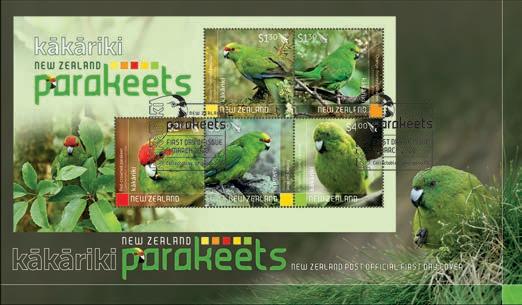
5 minute read
Bird watchers
Charged with the extraordinary goal of restoring a Wellington valley to its pre-human state, Zealandia – Te Māra a Tāne is the world’s first fully fenced ecosanctuary. In the past 20 years it has become home to numerous species of New Zealand’s native birds, including the small green parakeets known as kākāriki. Ellen Irwin is Lead Ranger Conservation at Zealandia, and is passionate about her work on this ambitious conservation project and how it supports Wellington’s bird (manu) populations to thrive.
What’s involved with your work at the ecosanctuary?
Zealandia’s vision is to restore the sanctuary to as close to pre-human condition as is now possible. This involves two main components: the removal of pests and reintroduction of native flora and fauna, including returning threatened species to the mainland. Those on the Conservation team spend much of our time monitoring the native species in the sanctuary and working to ensure the valley remains free of mammalian predators. This means that every day is different – I could be monitoring kākāriki nest boxes, checking a trap line and doing some data analysis on the computer all in the same day!
Tell us about the kākāriki at Zealandia.
Kākāriki were introduced to Zealandia in 2010 and since then have flourished – the birds can be seen, or more often heard, all over the valley. To help monitor the population, we have nearly 100 nest boxes throughout the valley that we check regularly during breeding season. Unlike many other birds in Zealandia, kākāriki have an incredibly long breeding season, sometimes stretching from August to May or even June. During that time, they can have up to three nests of around four to six chicks each!
Excitingly, kākāriki are now spreading out from Zealandia into many Wellington suburbs, such as Karori and Wilton and even Khandallah. They are very vulnerable to predation because they often feed on the ground, and they nest in cavities where there are no escape routes should predators enter the nest. Thankfully, there are many organisations and groups doing amazing trapping work around Wellington, making the suburbs safer for native manu like kākāriki.
What makes New Zealand’s birdlife special?
New Zealand’s birdlife is incredibly special and unique - for one, many of our manu are endemic, which means they are found nowhere else in the world! A big part of what makes the birds here so remarkable is that they evolved without mammalian predators, which means that many of them have unusual adaptations. For example the kiwi, which is flightless and nocturnal, and freezes when it encounters threats, is camouflaged from predators hunting it from the air. Unfortunately, many of these adaptations also mean that our species are very vulnerable to predation by introduced mammals like rats and stoats.
What impacts has Zealandia had on Wellington’s bird populations?
Zealandia has brought back bird species that had been extinct from the Wellington region, sometimes for more than 100 years. In addition, Zealandia has provided a safe haven for birds that were present prior to the sanctuary (e.g. tūī and kererū) in lower numbers. Because of both Zealandia and the incredible restoration efforts of many groups and organisations in the region, Wellington is one of the few cities in the world with increasing biodiversity!
How can Kiwis and visitors help to protect New Zealand’s native animals?
Kiwis can make their backyard safe havens for native species by trapping mammalian predators and planting native plant and tree species in their gardens to provide food and shelter for birds, lizards, and insects. They can also join local conservation groups – there are so many groups all over New Zealand doing amazing restoration work! Everyone can help protect New Zealand’s flora and fauna, whether you live here or are visiting, by taking care of the environment - e.g. not littering, leaving no trace in parks and reserves, and respecting the wildlife’s space.
If there were one thing you’d like people to take away from a visit to a place like Zealandia, what would it be?
Zealandia is a project that is community inspired and driven, and it has had a huge impact on Wellington’s biodiversity. I hope people come away feeling inspired and empowered to think about the kind of positive change they can make in their own communities, and shoot for the Moon.
Kākāriki - New Zealand Parakeets stamps and collectables were issued on 4 March 2020 and are available for order now.

$1.30 Yellow-crowned parakeet
By feeding mainly on invertebrates, flowers and seeds in the canopy of beech and podocarp forests, and by nesting high up in trees, Cyanoramphus auriceps have been more resistant to the threat of mammalian predators than other species.

$1.30 Orange-fronted parakeet
Because they feed on invertebrates, flowers and seeds in the lower levels of the forest, Cyanoramphus malherbi are very vulnerable to predators, so remain one of New Zealand’s most threatened birds.


$2.60 Red-crowned parakeet
Cyanoramphus novaezelandiae have largely disappeared from the New Zealand mainland, but flourish on many islands from the subtropical Kermadec Islands to the subantarctic Auckland Islands, and many offshore islands of Aotearoa.


$3.30 Forbes’ parakeet
In the distant past, the ancestors of yellow-crowned parakeets reached the Chatham Islands, and slowly changed sufficiently to be recognised as a distinct species, Cyanoramphus forbesi.


$4.00 Antipodes Island parakeet
Although they can fly, Cyanoramphus unicolor prefer to walk and climb through vegetation. Unusually, they feed on fat from seabird carcasses, on broken eggs, and can occasionally kill small seabirds.











